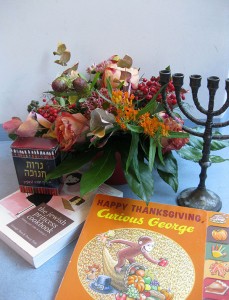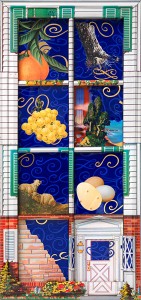Menurkeys for Thanksgivukkah?

Research under way in preparation for Thanksgivukkah
Photo: Signe Rossbach
Chanksgiving! As a family of German-American Jewish-Protestant-Catholic-Puritan backgrounds, we do like to celebrate as many holidays as we can possibly fit into our family schedule – with Halloween, our twins’ birthday and the classic German lantern parade for St. Martin’s day making for an action packed twelve days at the beginning of November.
After a bit of a breather we’re heading into the next holiday season – with a bit of a twist this year. Usually Hanukkah – the Jewish festival of lights and miracles – is associated with the Christian festival of lights and a miraculous birth: Christmas. And that makes sense, sort of, superficially at least. A few years ago we had an entire exhibition titled “Chrismukkah” – a cultural history of the evolution of the two holidays, and this year on December 3, Rabbi Daniel Katz will present a truly enjoyable talk on how they really don’t fit together at all.
But Thanksgiving? → continue reading

Seder Plate by Harriete Estel Berman, U.S.A., 2003 © photo: Jens Ziehe, Jewish Museum Berlin
Passover is not only a feast day evoking an historic event through a ritualized form of remembrance. It also appeals to reenact the exodus out of Egypt and envision divine mercy, freeing us from bondage and disenfranchisement. Like many Jewish holidays the original biblical Passover story has been and still is seen in relation to other historical events. The Egypt of the Exodus story turned into Ukraine and Belarus in the 17th century, when the Cossack chief Bogdan Chmielnicki allowed many hundreds of thousands of Jews to be murdered over the course of his struggle to liberate Poland. In the 20th century, Germany under the Nazi regime became the country to flee.
Through its culinarily-underscored recitation and discussion of the narrative, the seder provides a framework for each new re-interpretation. This appears primarily at the dinner: even while the symbolic dishes are determined by the Passover Haggadah, the other foods vary according to geography and the cultural conventions of the place where the celebration is taking place. There are especially numerous recipes for the “mortar,” the charoset, which resembles in color and texture the cementing agent used to build houses.
→ continue reading

